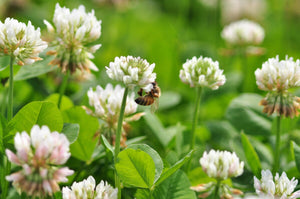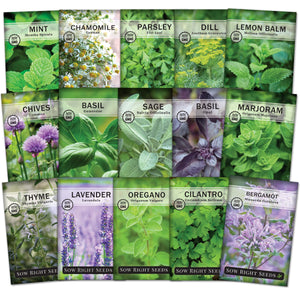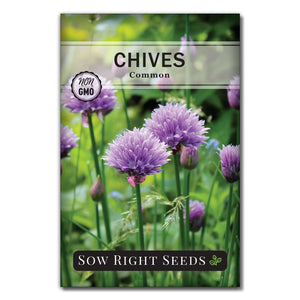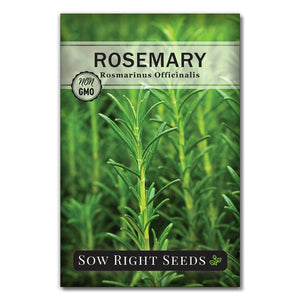Basil Varieties: Exploring the Different Types to Grow in Your Garden
Herb growing tipsBasil is one of the most widely used herbs in kitchens around the world, but did you know there are actually several different types of basil available?
From colorful Opal basil to citrusy Lemon, we'll take a closer look at the different varieties of basil and the specific characteristics that set them apart. Whether you're interested in trying out different flavors in your recipes or adding fragrance to your flower garden, learning about the various basil varieties will expand your gardening experience.

Your Guide to Varieties and Flavors of Basil to Grow
Basil is a versatile and fragrant herb that comes in many different varieties, each with its own unique flavor and characteristics. And although you might not find these varieties in the grocery store, they are easy to grow at home.
Unlike the grocery-store offerings, which have been sitting around for days or even weeks, you’ll enjoy fresher leaves and extraordinary taste with homegrown basil. No matter what flavor profile you're seeking for your next dish, there will surely be a type of basil suited to your needs!
Basil is also a beautiful filler flower or greenery to add to floral arrangements. Each variety has its own color and scent. If you are interested in flower farming, you can grow different types of basil and enhance your bouquets.

Genovese Basil

Sweet basil, also known as Genovese or Italian basil, is by far the most widely used variety. The leaves are large and fragrant, with a sweet anise flavor that makes it popular for Italian-style recipes like pesto and pasta sauces.
If you're looking for basil to make pesto, Genovese is your go-to basil variety. It's popular in many recipes and loved by home cooks and chefs for its fragrance and earthy flavor. Plus, it's known for its antioxidants and can help with stomach problems when made into tea. Genovese basil is really versatile and has so many possibilities! Try it in our 5-minute basil pesto recipe.
What does Genovese Basil taste like? Genovese basil has a sweet and slightly spicy flavor with hints of clove and anise. It is often described as having a strong and aromatic taste that is both refreshing and intense.
Thai Basil

Thai basil is a popular and distinctive variety originating from Southeast Asia. It has an earthy and sweet flavor profile with hints of spice and subtle licorice undertones that make it completely different from its close relative, Sweet Basil.
This type of basil can take the high heat in cooking, making it prevalent in Asian cuisine. Thai basil’s distinctive flavor is a crucial ingredient in dishes like pad thai or tom kha gai soup. I love having this on hand for pad kee mao (drunken noodles).
Grow Thai basil in your flower garden! Thai basil produces beautiful purple stems with lighter purple flowers. They are long-lasting in floral arrangements. Thai basil plants will continue to branch and produce more when they are cut.
What does Thai Basil taste like? Thai basil has a unique flavor that is often described as sweet and slightly spicy, with hints of licorice and mint. It has a more robust and more intense flavor compared to regular basil.
Purple/Opal Basil

Opal basil is a vibrant plant with captivating dark purple coloration throughout the entire plant. It makes a beautiful addition to a cutting garden where it can be harvested to use in floral arrangements. Use opal basil as a filler flower when it blooms with pink flowers. Or use the purple leaves for “greenery” at any time.
The flavor and fragrance of Purple basil is a touch subtler than traditional basil varieties, making it best enjoyed raw in order to appreciate the beautiful hue. It adds a dramatic punch to dishes like tomato salads such as Caprese and Panzanella.
What does Opal Basil taste like? Opal basil has a unique flavor that is similar to sweet basil but with some differences. It has a slightly stronger and more peppery taste, with hints of clove and anise. It also has a somewhat minty undertone, adding a refreshing element to its flavor profile.
Grow basil for fragrant foliage in fresh flower arrangements.
Lemon Basil

Lemon basil is an amazing herb that packs a citrusy punch to any dish. Native to India, it’s become a staple part of Southeast Asian cuisine. From adding it to meat dishes, vegetables like zucchini and asparagus, soups, and more - Lemon basil can do no wrong. The sweet and tangy flavor pairs wonderfully with savory yet light cuisine - the perfect balance of sweetness and tartness. When cooking with Lemon basil, be sure to add it near the end of your recipe so its delicate citrus and anise notes really shine.
Grow lemon basil for its beautiful green leaves and lemony scent. Cutting it before it blooms will encourage more growth. But you can also let it flower to use the white flowers that will top the plant. The scent makes a delightful addition to fresh flower arrangements.
What does Lemon Basil taste like? Lemon basil has a unique flavor profile that combines the citrusy and refreshing taste of lemon with the aromatic and slightly sweet notes of basil. It has a bright and zesty flavor that adds a refreshing twist to dishes.
Holy Basil

Holy Basil, also known as Tulsi, is no ordinary basil. It has a unique history behind its name; this special type of basil is highly respected within the Hindu religion. It’s not uncommon to find Holy Basil used in prayers and placed at the gateways of temples all across India.
The benefits of Holy Basil extend far beyond spiritual admiration, however. It can be made into a tea to drink regularly as an immune system booster, and its antioxidant power helps the body fight disease-causing radicals. This aromatic herb also has anti-anxiety properties, allowing your mind and body to relax from stress and fatigue. Plus, it aids in digestion with its natural digestive enzyme compounds and helps reduce inflammation with its anti-inflammatory agents. All these benefits make for a fantastic herbal treat—all wrapped up in one plant!
What does Holy Basil taste like? Holy basil has a distinct and slightly peppery taste with hints of clove and mint. It is often described as having a strong and pungent flavor, similar to regular basil, but with a more pronounced spiciness.
Greek Basil

Grow Greek basil for its shape as well as its culinary uses. Its small size sets it apart from regular basil, while its bushy growth pattern gives it a unique charm. Greek basil has smaller leaves than other types of basil. And instead of growing into a tall flowering plant, it has a short, mounding habit. This makes it a nice choice for an edible landscape plant or an easy-care ornamental.
Popular dishes such as tzatziki are often made with Greek basil; its mild aroma and delicate flavor pairs perfectly with olives and feta cheese for an authentically Greek culinary experience. The small leaves make Greek basil easy to add as a garnish.
What does Greek Basil taste like? Greek basil is sweeter than Genovese basil, with a stronger taste of cloves.

Basil is an easy-to-grow, delicious herb. This annual plant will reward you with prolific leaves as well as flowers if it is cut often.
Basil plants can be added to container gardens and flower beds. Basil is also an excellent companion plant in your vegetable garden. Plant it next to your tomatoes for better flavor and pest deterrent. Basil can even be grown indoors in a pot or hydroponic system.
Whether you’re looking for Holy Basil, Thai Basil, or any other variety, we've got the right basil seeds for your specific needs.
Add a unique flavor to your herb garden with a new type of basil. Our planting and growing instructions will ensure you can successfully grow basil.
Fresh basil is always in season when you grow your own.









Leave a comment